Business Ethics and Law: Misleading Advertisements' Impact on Children
VerifiedAdded on 2022/09/10
|6
|1318
|22
Report
AI Summary
This report investigates the ethical and legal implications of misleading advertisements, particularly their impact on children. It explores the concept of "pester power" and how children influence purchasing decisions due to advertising. The report analyzes relevant laws, such as Section 18 of the Australian Consumer Law enforced by the Australian Competition and Consumer Commission (ACCC), and presents a case study of Samsung's misleading claims regarding the water resistance of its phones. Furthermore, it examines the AANA code, which provides guidelines for marketing products to children, focusing on factors like social values and privacy. Finally, the report discusses ethical theories, including virtue ethics, consequentialism, and deontology, to evaluate the ethicality of misleading advertisements. The report concludes that misleading advertisements are unethical because they do not align with ethical principles and can harm children.
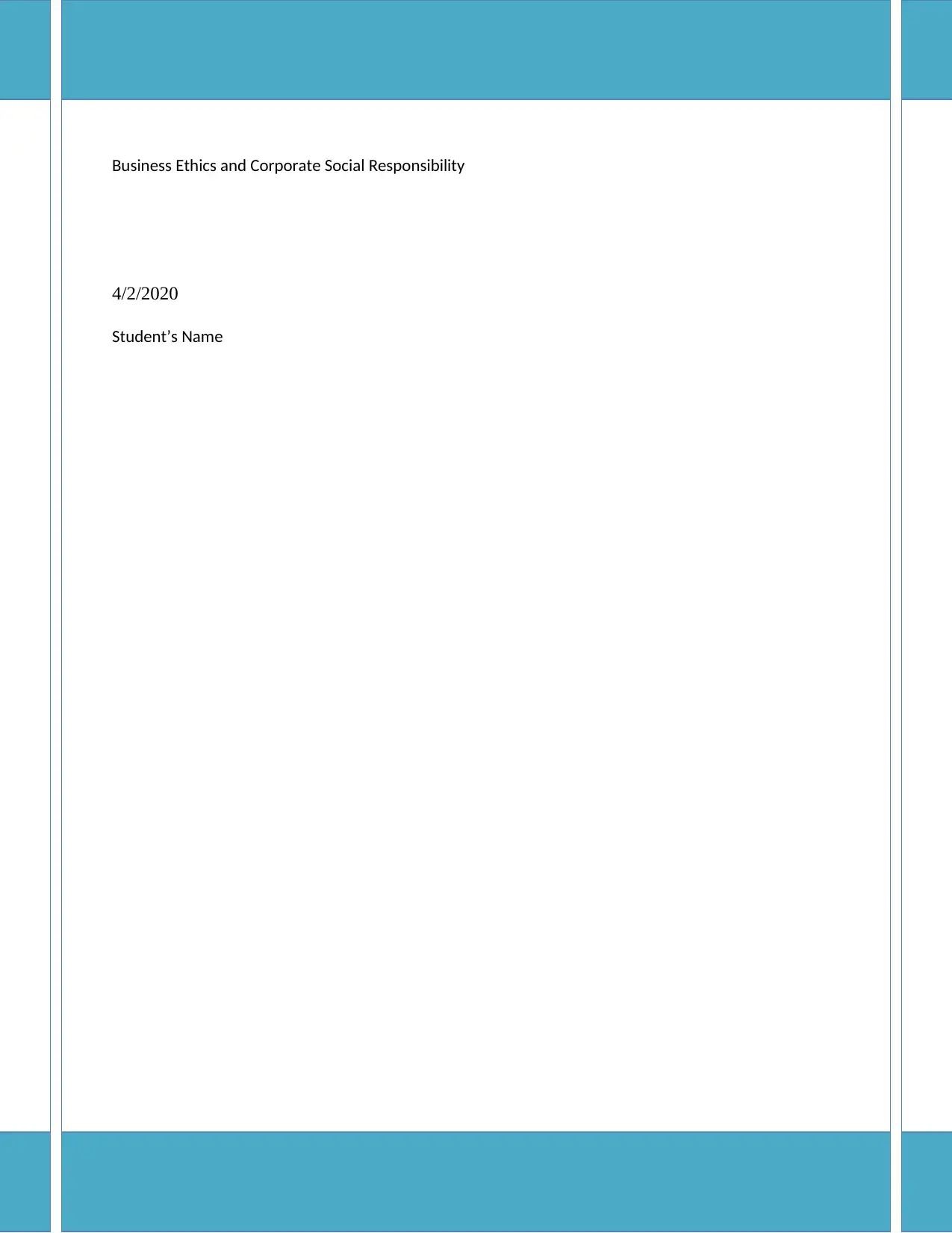
Running Head: BUSINESS AND CORPORATION LAW 0
Business Ethics and Corporate Social Responsibility
4/2/2020
Student’s Name
Business Ethics and Corporate Social Responsibility
4/2/2020
Student’s Name
Paraphrase This Document
Need a fresh take? Get an instant paraphrase of this document with our AI Paraphraser
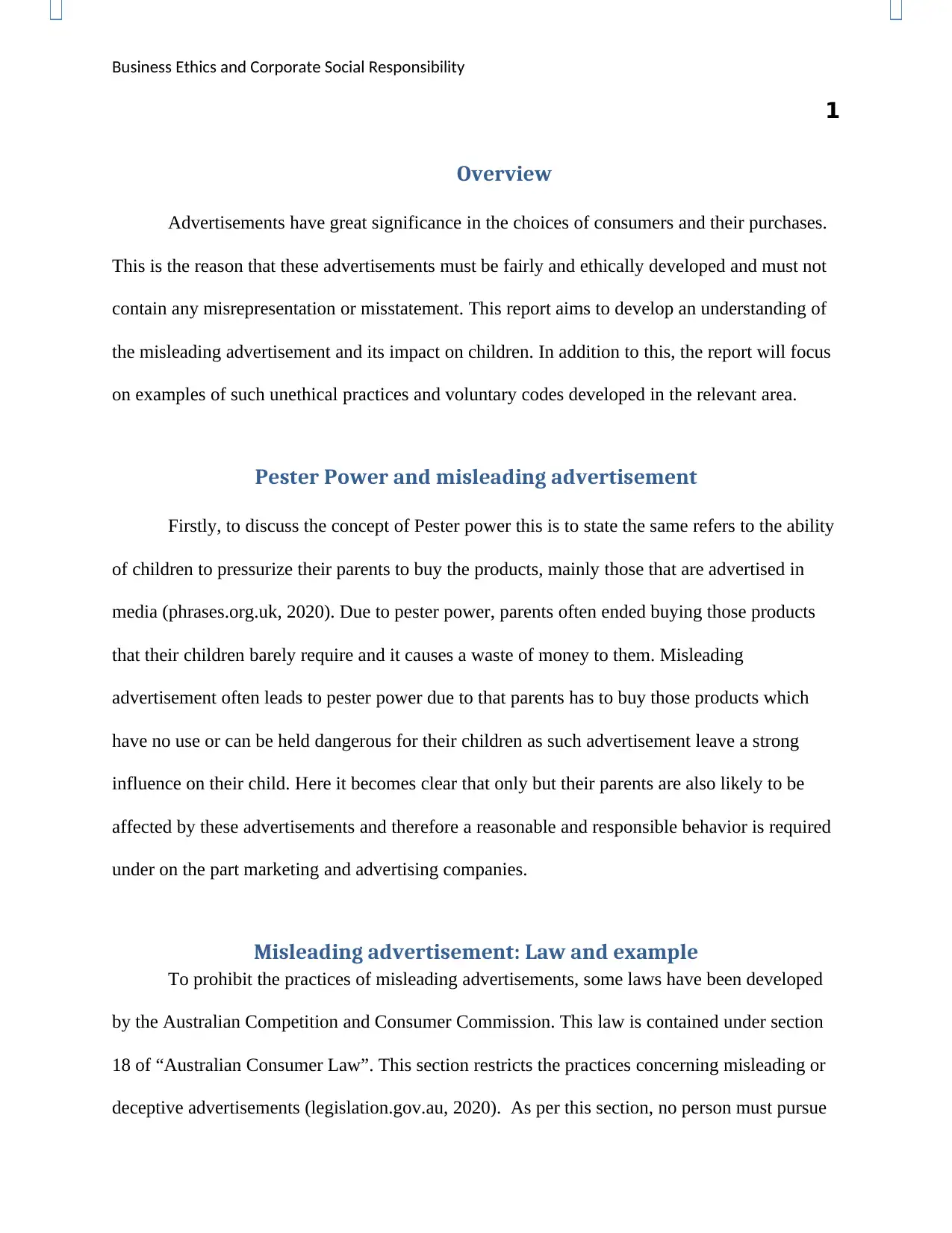
Business Ethics and Corporate Social Responsibility
1
Overview
Advertisements have great significance in the choices of consumers and their purchases.
This is the reason that these advertisements must be fairly and ethically developed and must not
contain any misrepresentation or misstatement. This report aims to develop an understanding of
the misleading advertisement and its impact on children. In addition to this, the report will focus
on examples of such unethical practices and voluntary codes developed in the relevant area.
Pester Power and misleading advertisement
Firstly, to discuss the concept of Pester power this is to state the same refers to the ability
of children to pressurize their parents to buy the products, mainly those that are advertised in
media (phrases.org.uk, 2020). Due to pester power, parents often ended buying those products
that their children barely require and it causes a waste of money to them. Misleading
advertisement often leads to pester power due to that parents has to buy those products which
have no use or can be held dangerous for their children as such advertisement leave a strong
influence on their child. Here it becomes clear that only but their parents are also likely to be
affected by these advertisements and therefore a reasonable and responsible behavior is required
under on the part marketing and advertising companies.
Misleading advertisement: Law and example
To prohibit the practices of misleading advertisements, some laws have been developed
by the Australian Competition and Consumer Commission. This law is contained under section
18 of “Australian Consumer Law”. This section restricts the practices concerning misleading or
deceptive advertisements (legislation.gov.au, 2020). As per this section, no person must pursue
1
Overview
Advertisements have great significance in the choices of consumers and their purchases.
This is the reason that these advertisements must be fairly and ethically developed and must not
contain any misrepresentation or misstatement. This report aims to develop an understanding of
the misleading advertisement and its impact on children. In addition to this, the report will focus
on examples of such unethical practices and voluntary codes developed in the relevant area.
Pester Power and misleading advertisement
Firstly, to discuss the concept of Pester power this is to state the same refers to the ability
of children to pressurize their parents to buy the products, mainly those that are advertised in
media (phrases.org.uk, 2020). Due to pester power, parents often ended buying those products
that their children barely require and it causes a waste of money to them. Misleading
advertisement often leads to pester power due to that parents has to buy those products which
have no use or can be held dangerous for their children as such advertisement leave a strong
influence on their child. Here it becomes clear that only but their parents are also likely to be
affected by these advertisements and therefore a reasonable and responsible behavior is required
under on the part marketing and advertising companies.
Misleading advertisement: Law and example
To prohibit the practices of misleading advertisements, some laws have been developed
by the Australian Competition and Consumer Commission. This law is contained under section
18 of “Australian Consumer Law”. This section restricts the practices concerning misleading or
deceptive advertisements (legislation.gov.au, 2020). As per this section, no person must pursue
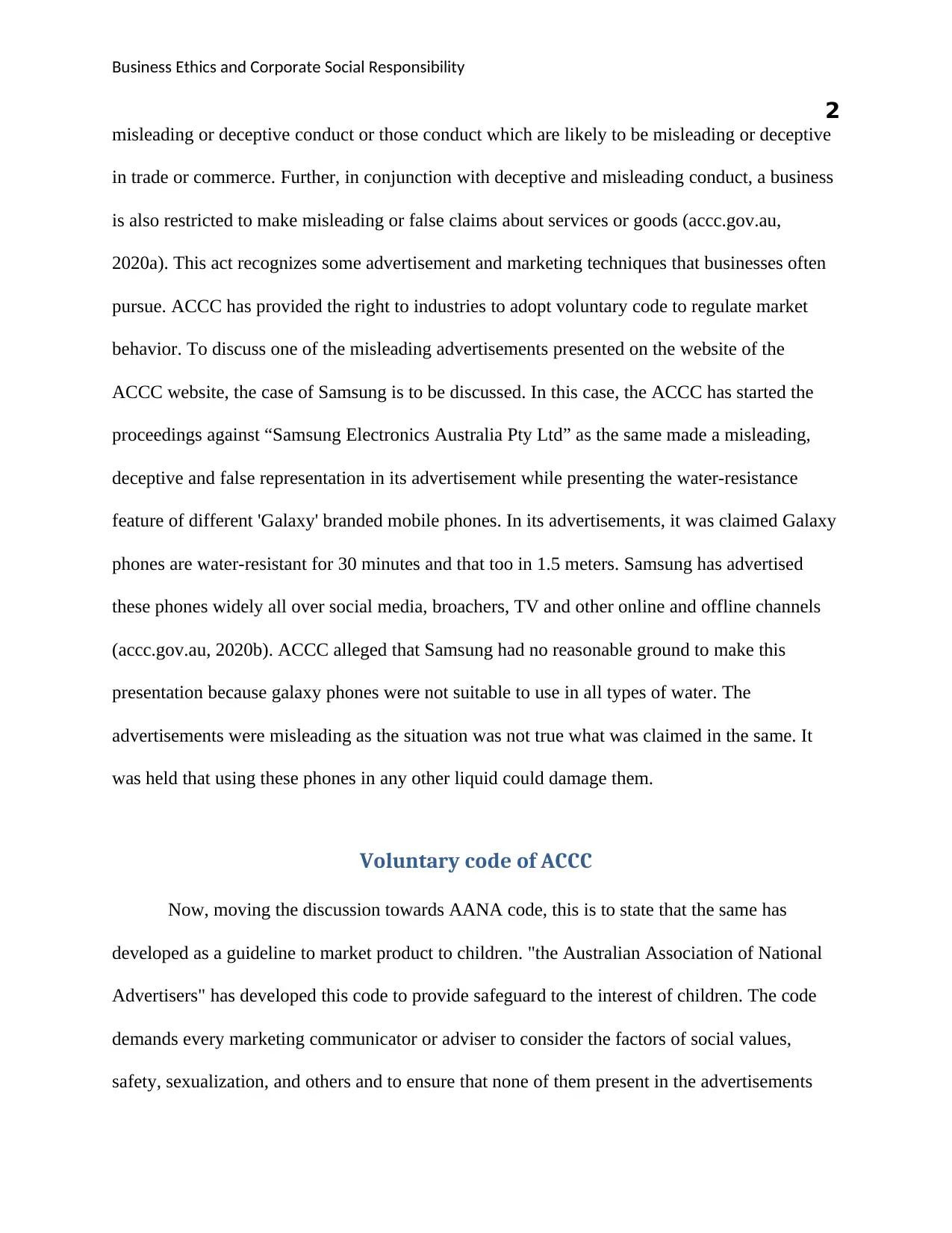
Business Ethics and Corporate Social Responsibility
2
misleading or deceptive conduct or those conduct which are likely to be misleading or deceptive
in trade or commerce. Further, in conjunction with deceptive and misleading conduct, a business
is also restricted to make misleading or false claims about services or goods (accc.gov.au,
2020a). This act recognizes some advertisement and marketing techniques that businesses often
pursue. ACCC has provided the right to industries to adopt voluntary code to regulate market
behavior. To discuss one of the misleading advertisements presented on the website of the
ACCC website, the case of Samsung is to be discussed. In this case, the ACCC has started the
proceedings against “Samsung Electronics Australia Pty Ltd” as the same made a misleading,
deceptive and false representation in its advertisement while presenting the water-resistance
feature of different 'Galaxy' branded mobile phones. In its advertisements, it was claimed Galaxy
phones are water-resistant for 30 minutes and that too in 1.5 meters. Samsung has advertised
these phones widely all over social media, broachers, TV and other online and offline channels
(accc.gov.au, 2020b). ACCC alleged that Samsung had no reasonable ground to make this
presentation because galaxy phones were not suitable to use in all types of water. The
advertisements were misleading as the situation was not true what was claimed in the same. It
was held that using these phones in any other liquid could damage them.
Voluntary code of ACCC
Now, moving the discussion towards AANA code, this is to state that the same has
developed as a guideline to market product to children. "the Australian Association of National
Advertisers" has developed this code to provide safeguard to the interest of children. The code
demands every marketing communicator or adviser to consider the factors of social values,
safety, sexualization, and others and to ensure that none of them present in the advertisements
2
misleading or deceptive conduct or those conduct which are likely to be misleading or deceptive
in trade or commerce. Further, in conjunction with deceptive and misleading conduct, a business
is also restricted to make misleading or false claims about services or goods (accc.gov.au,
2020a). This act recognizes some advertisement and marketing techniques that businesses often
pursue. ACCC has provided the right to industries to adopt voluntary code to regulate market
behavior. To discuss one of the misleading advertisements presented on the website of the
ACCC website, the case of Samsung is to be discussed. In this case, the ACCC has started the
proceedings against “Samsung Electronics Australia Pty Ltd” as the same made a misleading,
deceptive and false representation in its advertisement while presenting the water-resistance
feature of different 'Galaxy' branded mobile phones. In its advertisements, it was claimed Galaxy
phones are water-resistant for 30 minutes and that too in 1.5 meters. Samsung has advertised
these phones widely all over social media, broachers, TV and other online and offline channels
(accc.gov.au, 2020b). ACCC alleged that Samsung had no reasonable ground to make this
presentation because galaxy phones were not suitable to use in all types of water. The
advertisements were misleading as the situation was not true what was claimed in the same. It
was held that using these phones in any other liquid could damage them.
Voluntary code of ACCC
Now, moving the discussion towards AANA code, this is to state that the same has
developed as a guideline to market product to children. "the Australian Association of National
Advertisers" has developed this code to provide safeguard to the interest of children. The code
demands every marketing communicator or adviser to consider the factors of social values,
safety, sexualization, and others and to ensure that none of them present in the advertisements
⊘ This is a preview!⊘
Do you want full access?
Subscribe today to unlock all pages.

Trusted by 1+ million students worldwide
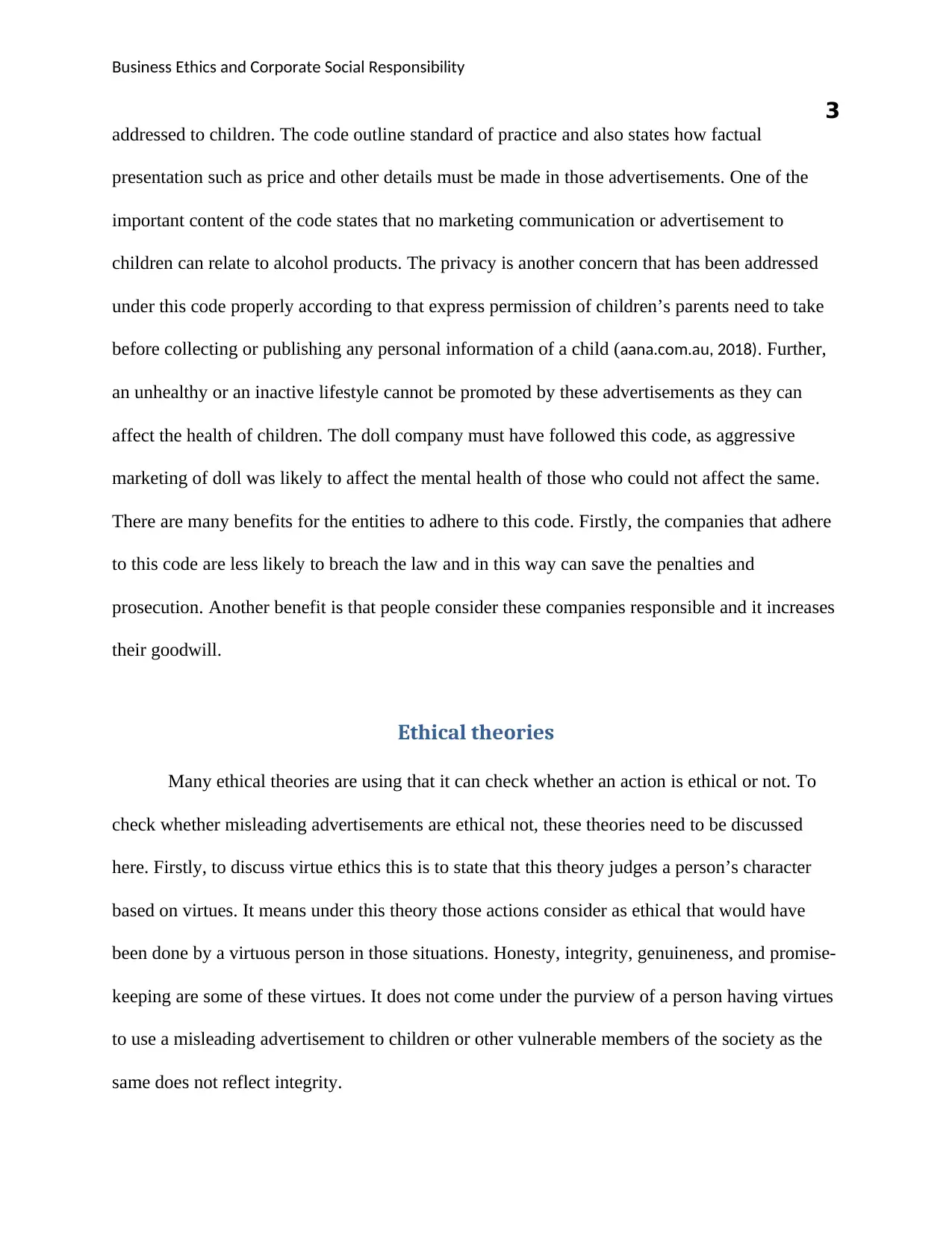
Business Ethics and Corporate Social Responsibility
3
addressed to children. The code outline standard of practice and also states how factual
presentation such as price and other details must be made in those advertisements. One of the
important content of the code states that no marketing communication or advertisement to
children can relate to alcohol products. The privacy is another concern that has been addressed
under this code properly according to that express permission of children’s parents need to take
before collecting or publishing any personal information of a child (aana.com.au, 2018). Further,
an unhealthy or an inactive lifestyle cannot be promoted by these advertisements as they can
affect the health of children. The doll company must have followed this code, as aggressive
marketing of doll was likely to affect the mental health of those who could not affect the same.
There are many benefits for the entities to adhere to this code. Firstly, the companies that adhere
to this code are less likely to breach the law and in this way can save the penalties and
prosecution. Another benefit is that people consider these companies responsible and it increases
their goodwill.
Ethical theories
Many ethical theories are using that it can check whether an action is ethical or not. To
check whether misleading advertisements are ethical not, these theories need to be discussed
here. Firstly, to discuss virtue ethics this is to state that this theory judges a person’s character
based on virtues. It means under this theory those actions consider as ethical that would have
been done by a virtuous person in those situations. Honesty, integrity, genuineness, and promise-
keeping are some of these virtues. It does not come under the purview of a person having virtues
to use a misleading advertisement to children or other vulnerable members of the society as the
same does not reflect integrity.
3
addressed to children. The code outline standard of practice and also states how factual
presentation such as price and other details must be made in those advertisements. One of the
important content of the code states that no marketing communication or advertisement to
children can relate to alcohol products. The privacy is another concern that has been addressed
under this code properly according to that express permission of children’s parents need to take
before collecting or publishing any personal information of a child (aana.com.au, 2018). Further,
an unhealthy or an inactive lifestyle cannot be promoted by these advertisements as they can
affect the health of children. The doll company must have followed this code, as aggressive
marketing of doll was likely to affect the mental health of those who could not affect the same.
There are many benefits for the entities to adhere to this code. Firstly, the companies that adhere
to this code are less likely to breach the law and in this way can save the penalties and
prosecution. Another benefit is that people consider these companies responsible and it increases
their goodwill.
Ethical theories
Many ethical theories are using that it can check whether an action is ethical or not. To
check whether misleading advertisements are ethical not, these theories need to be discussed
here. Firstly, to discuss virtue ethics this is to state that this theory judges a person’s character
based on virtues. It means under this theory those actions consider as ethical that would have
been done by a virtuous person in those situations. Honesty, integrity, genuineness, and promise-
keeping are some of these virtues. It does not come under the purview of a person having virtues
to use a misleading advertisement to children or other vulnerable members of the society as the
same does not reflect integrity.
Paraphrase This Document
Need a fresh take? Get an instant paraphrase of this document with our AI Paraphraser
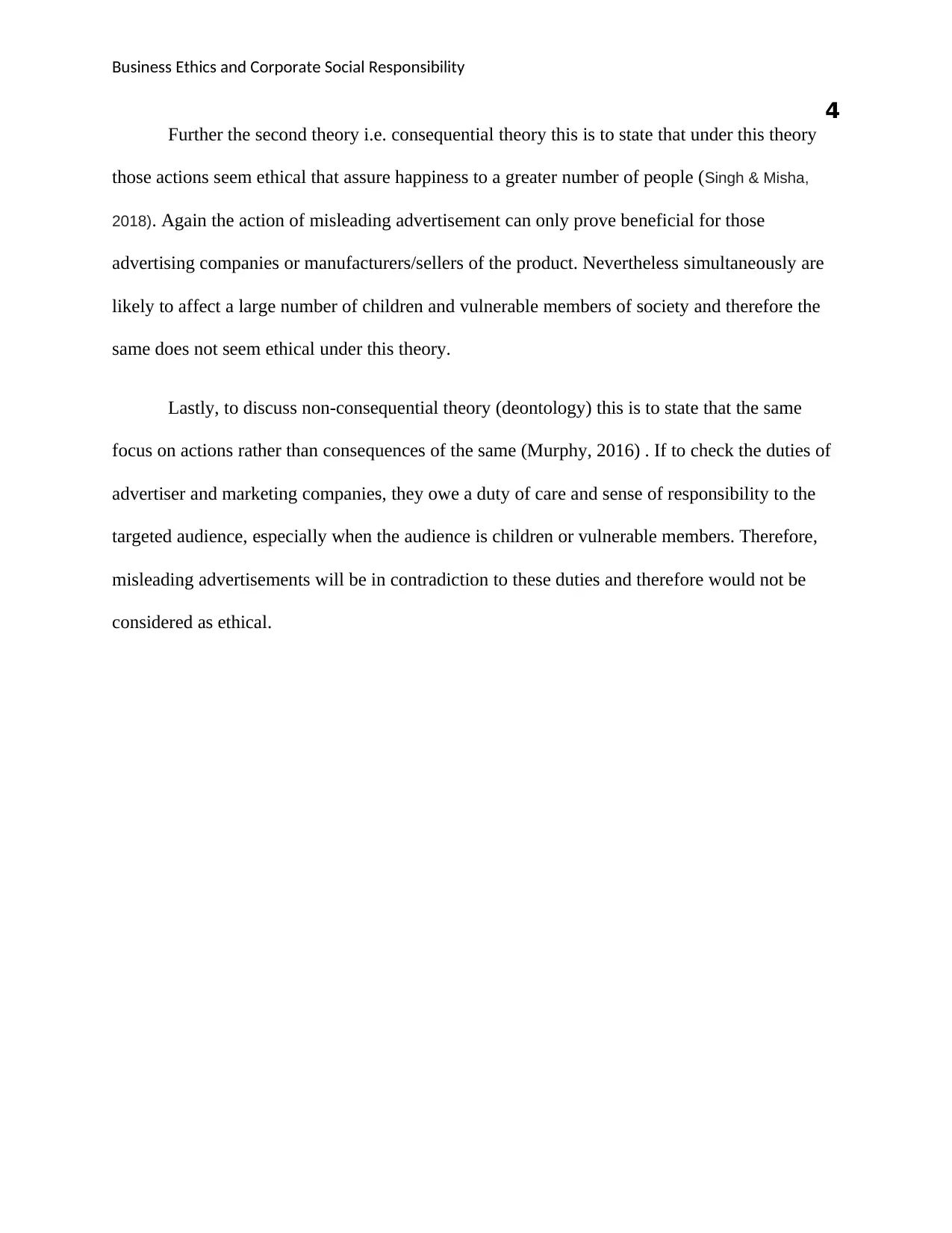
Business Ethics and Corporate Social Responsibility
4
Further the second theory i.e. consequential theory this is to state that under this theory
those actions seem ethical that assure happiness to a greater number of people (Singh & Misha,
2018). Again the action of misleading advertisement can only prove beneficial for those
advertising companies or manufacturers/sellers of the product. Nevertheless simultaneously are
likely to affect a large number of children and vulnerable members of society and therefore the
same does not seem ethical under this theory.
Lastly, to discuss non-consequential theory (deontology) this is to state that the same
focus on actions rather than consequences of the same (Murphy, 2016) . If to check the duties of
advertiser and marketing companies, they owe a duty of care and sense of responsibility to the
targeted audience, especially when the audience is children or vulnerable members. Therefore,
misleading advertisements will be in contradiction to these duties and therefore would not be
considered as ethical.
4
Further the second theory i.e. consequential theory this is to state that under this theory
those actions seem ethical that assure happiness to a greater number of people (Singh & Misha,
2018). Again the action of misleading advertisement can only prove beneficial for those
advertising companies or manufacturers/sellers of the product. Nevertheless simultaneously are
likely to affect a large number of children and vulnerable members of society and therefore the
same does not seem ethical under this theory.
Lastly, to discuss non-consequential theory (deontology) this is to state that the same
focus on actions rather than consequences of the same (Murphy, 2016) . If to check the duties of
advertiser and marketing companies, they owe a duty of care and sense of responsibility to the
targeted audience, especially when the audience is children or vulnerable members. Therefore,
misleading advertisements will be in contradiction to these duties and therefore would not be
considered as ethical.
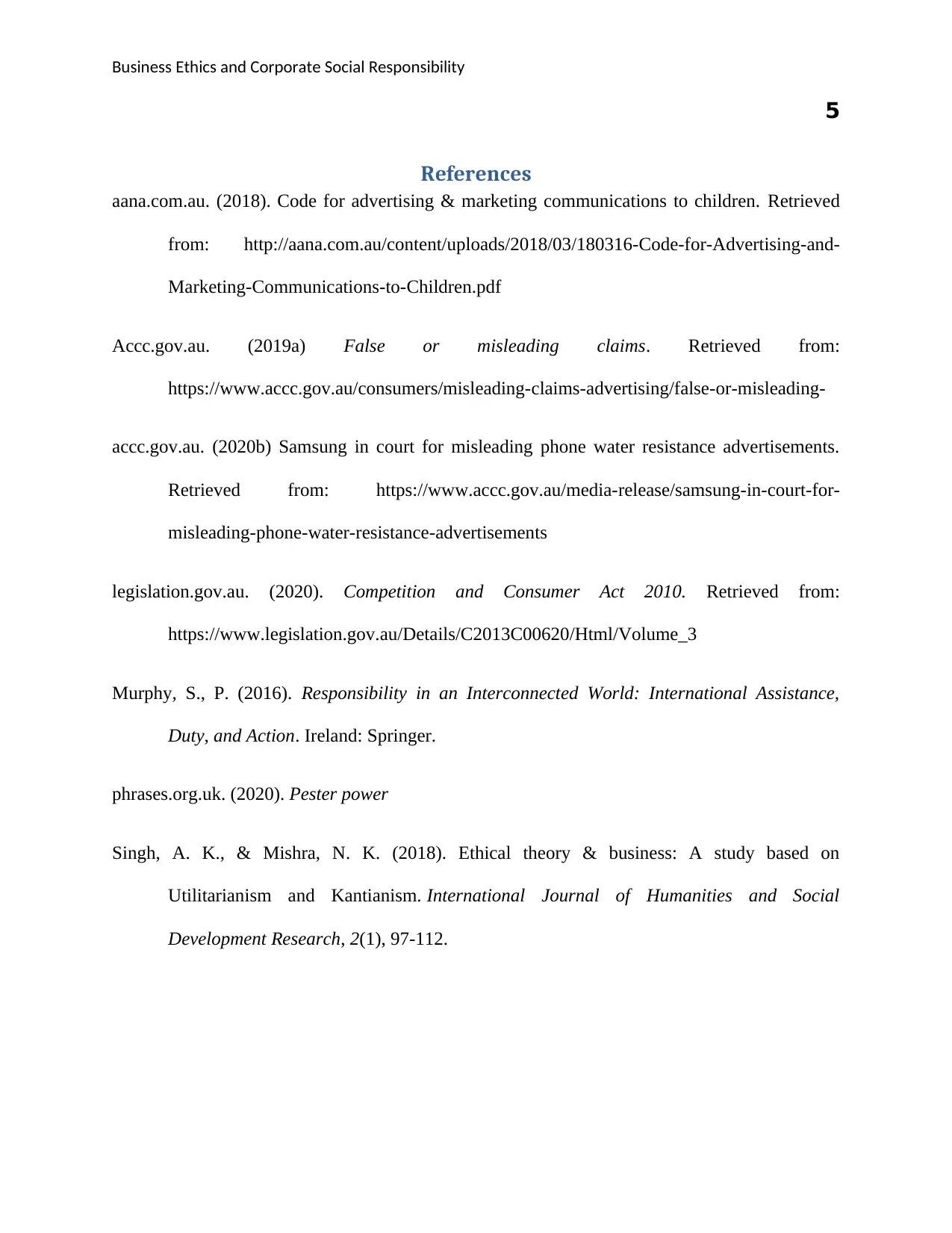
Business Ethics and Corporate Social Responsibility
5
References
aana.com.au. (2018). Code for advertising & marketing communications to children. Retrieved
from: http://aana.com.au/content/uploads/2018/03/180316-Code-for-Advertising-and-
Marketing-Communications-to-Children.pdf
Accc.gov.au. (2019a) False or misleading claims. Retrieved from:
https://www.accc.gov.au/consumers/misleading-claims-advertising/false-or-misleading-
accc.gov.au. (2020b) Samsung in court for misleading phone water resistance advertisements.
Retrieved from: https://www.accc.gov.au/media-release/samsung-in-court-for-
misleading-phone-water-resistance-advertisements
legislation.gov.au. (2020). Competition and Consumer Act 2010. Retrieved from:
https://www.legislation.gov.au/Details/C2013C00620/Html/Volume_3
Murphy, S., P. (2016). Responsibility in an Interconnected World: International Assistance,
Duty, and Action. Ireland: Springer.
phrases.org.uk. (2020). Pester power
Singh, A. K., & Mishra, N. K. (2018). Ethical theory & business: A study based on
Utilitarianism and Kantianism. International Journal of Humanities and Social
Development Research, 2(1), 97-112.
5
References
aana.com.au. (2018). Code for advertising & marketing communications to children. Retrieved
from: http://aana.com.au/content/uploads/2018/03/180316-Code-for-Advertising-and-
Marketing-Communications-to-Children.pdf
Accc.gov.au. (2019a) False or misleading claims. Retrieved from:
https://www.accc.gov.au/consumers/misleading-claims-advertising/false-or-misleading-
accc.gov.au. (2020b) Samsung in court for misleading phone water resistance advertisements.
Retrieved from: https://www.accc.gov.au/media-release/samsung-in-court-for-
misleading-phone-water-resistance-advertisements
legislation.gov.au. (2020). Competition and Consumer Act 2010. Retrieved from:
https://www.legislation.gov.au/Details/C2013C00620/Html/Volume_3
Murphy, S., P. (2016). Responsibility in an Interconnected World: International Assistance,
Duty, and Action. Ireland: Springer.
phrases.org.uk. (2020). Pester power
Singh, A. K., & Mishra, N. K. (2018). Ethical theory & business: A study based on
Utilitarianism and Kantianism. International Journal of Humanities and Social
Development Research, 2(1), 97-112.
⊘ This is a preview!⊘
Do you want full access?
Subscribe today to unlock all pages.

Trusted by 1+ million students worldwide
1 out of 6
Your All-in-One AI-Powered Toolkit for Academic Success.
+13062052269
info@desklib.com
Available 24*7 on WhatsApp / Email
![[object Object]](/_next/static/media/star-bottom.7253800d.svg)
Unlock your academic potential
Copyright © 2020–2025 A2Z Services. All Rights Reserved. Developed and managed by ZUCOL.

